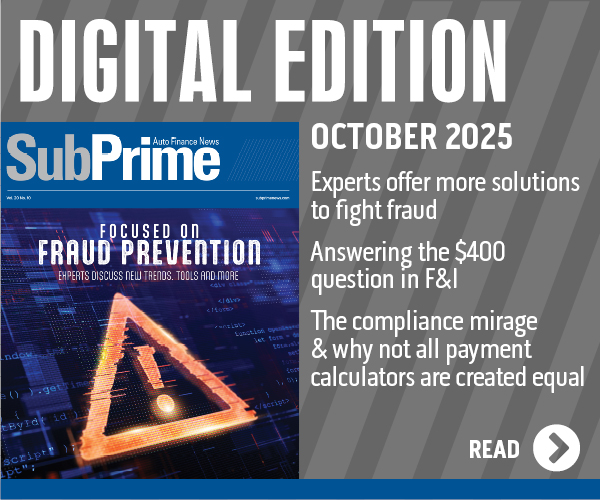CFPB Wants More Consumer Complaint Info Out in Public

By subscribing, you agree to receive communications from Auto Remarketing and our partners in accordance with our Privacy Policy. We may share your information with select partners and sponsors who may contact you about their products and services. You may unsubscribe at any time.
WASHINGTON, D.C. –
Back in March, Consumer Financial Protection Bureau director Richard Cordray referred to complaints as the agency’s “compass,” because these consumer statements “make a difference by informing our work and helping us identify and prioritize problems for potential action.”
If policy changes the CFPB suggested this week come to be, Cordray and the rest of the bureau’s regulators will be sharing information connected to that “compass” in much greater detail.
The CFPB is proposing a new policy that would empower consumers to publicly voice their complaints about consumer financial products and services. When consumers submit a complaint to the CFPB, they would have the option to share their account of what happened in the CFPB’s public-facing Consumer Complaint Database.
Cordray contends that publishing consumer narratives would provide important context to the complaint, help the public detect specific trends in the market, aid consumer decision-making and drive improved consumer service.
“The consumer experience shared in the narrative is the heart and soul of the complaint,” Cordray said. “By publicly voicing their complaint, consumers can stand up for themselves and others who have experienced the same problem.
“There is power in their stories, and that power can be put in service to strengthen the foundation for consumers, responsible providers and our economy as a whole,” he went on to say.
Subscribe to Auto Remarketing to stay informed and stay ahead.
By subscribing, you agree to receive communications from Auto Remarketing and our partners in accordance with our Privacy Policy. We may share your information with select partners and sponsors who may contact you about their products and services. You may unsubscribe at any time.
The CFPB is already getting some pushback about this proposal. One of the first industry leaders to speak up was Richard Hunt, president and chief executive officer of the Consumer Bankers Association.
“Publishing narratives of every unverified complaint will give only the illusion of disclosure. Banks have an obligation to their customers to maintain the confidentiality of their information, making it virtually impossible for a bank to offer a complete response to these narratives,” Hunt said.
“It is the role of the CFPB as the traffic cop to distinguish violations of law from unfounded complaints,” he continued. “Instead, they want to let others figure it out from one-sided and unverified narrative information. This action will ultimately add to consumer confusion, harm industry reputations and undermine any hope the CFPB may have to be viewed as a fair and honest broker.
“For an agency which prides itself on being driven by ‘accurate’ data, this is very disappointing,” Hunt went on to say.
The CFPB pointed out that it began accepting complaints as soon as it opened its doors three years ago in July 2011. The agency currently accepts complaints on many consumer financial products, including credit cards, mortgages, bank accounts, private student loans, vehicle and other consumer loans, credit reporting, money transfers, debt collection and payday loans.
When consumers submit a complaint to the bureau, they fill in information such as who they are, who the complaint is against and when it occurred. They are also given a text box to describe what happened and can attach documents to the complaint.
The bureau forwards the complaint to the company, allows the company to respond, gives the consumer a tracking number and keeps the consumer updated on its status.
To date, the bureau has handled more than 400,000 complaints.
The CFPB’s Consumer Complaint Database is the nation’s largest public collection of consumer financial complaints. It includes basic, anonymous, individual-level information about the complaints received, including the date of submission, the consumer’s ZIP code, the relevant company, the product type, the issue the consumer is complaining about and the company’s response.
Adding Narratives to the Consumer Complaint Database
The bureau spelled out more details of its proposal to expand the database to include the consumer’s narrative description of what happened.
“In many ways, the narratives are the most insightful part of a complaint,” CFPB officials said. “They provide a first-hand account of the consumer’s experience and the problem they would like resolved.
“By giving consumers an option to publicly share their stories, the CFPB would greatly enhance the utility of the database, a platform designed to provide consumers with valuable information needed to make better financial choices for themselves and their families,” they continued.
The bureau went on to rattle off four addition benefits the agency contends will come from sharing the narratives, including:
— Providing context to the complaint: While the current database captures the basics of a consumer’s complaint, the bureau believes the amount of context provided is limited. Complaints are grouped into dozens of high-level categories such as “billing disputes,” “transaction issues,” or “advertising and marketing.”
Officials said, “Including the consumer’s narrative would increase the level of detail available to consumers, consumer groups, and companies in the market.”
For example, the CFPB explained that providing the complaint narratives within the mortgage category of “loan modification, collection, foreclosure,” would help determine if the consumer is being charged extra fees, the servicer has lost paperwork, or any number of other specific problems.
“Describing the circumstances can provide vital information about why the consumer believes they were harmed, and the impact that harm has had on the consumer,” the agency said.
— Spotlighting specific trends: Not only does the narrative provide context to the individual complaint, but the CFPB also thinks it can provides context to the marketplace.
“Narratives allow the public to detect trends across the consumer experience and pinpoint problems,” officials said. “With narratives, it is possible to see if a specific issue is localized in a particular geographic area or with a specific company, or if it’s a practice used by companies across the product market.”
The CFPB noted reviewers may see that a number of consumers are starting to receive a $10 mystery charge from a particular company. Or they may see that a city is experiencing a rise in complaints about specific problems with mortgage loan modification denials. Or they may see that more and more companies are failing to meet their student loan servicing obligations.
“Without the narrative, the public cannot fully connect the dots,” the CFPB said.
— Helping consumers make informed decisions: Consumers often go online to research products before they make a decision to purchase.
“Including the details of a complaint would help inform consumers who are considering a particular product or service,” officials said.
The CFPB emphasized that databases with narratives, such as the Consumer Product Safety Commission’s SaferProducts.gov or the National Highway Traffic Safety Administration’s SaferCar.gov, have helped inform consumers about a range of products from cribs to vehicles.
“The CFPB aims to empower consumers with the same kind of information. Reviewers could use the narrative to decide for themselves if the problems experienced by other consumers would stop them from purchasing the same product or service,” officials said.
— Spurring competition based on consumer satisfaction: With these stories readily available to the public, the bureau thinks companies may have additional incentives to address potential “shortcomings” in their businesses that could have negative impacts on consumers.
“In the end, the narratives may encourage companies to improve the overall quality of their goods and services and more vigorously compete over good customer service, all of which has the potential to improve the functioning, transparency, and efficiency of the market,” officials said.
Safeguards for Publishing Process
In an attempt to refute points raised by industry leaders such as the CBA’s Hunt, the CFPB indicated its proposed policy is geared to recognize the importance of protecting consumers’ private information, ensuring the informed consent of any consumer who participates and providing companies with an opportunity to respond.
The bureau pointed out that its proposal establishes a number of important safeguards for a clear, fair and transparent process, including:
— Consumers must opt-in: The CFPB would not publish the complaint narrative unless the consumer provides informed consent.
“This means that when consumers submit a complaint through consumerfinance.gov, they would have to affirmatively check a consent box to give the bureau permission to publish their narrative. At least initially, only narratives submitted online would be available for the opt-in,” officials said.
— No personal information will be shared: The bureau insisted it would take all reasonable steps to remove personal information from the complaint to minimize the risk of someone being able to identify the consumer.
“This means complaints would be scrubbed of information such as names, telephone numbers, account numbers, Social Security numbers and other direct identifiers,” officials said.
— Finance companies can publish their response. Operations would be given the opportunity to post a written response that would appear next to the consumer’s story.
“In most cases, this response would appear at the same time as the consumer’s narrative so that reviewers can see both sides concurrently,” the CFPB said. “This response would also be scrubbed of personal information.”
— Consumers can opt-out at any time: If a consumer decides at any time that he or she would like to withdraw consent to publish their narrative in the Consumer Complaint Database, the CFPB said he or she will have the ability to do so.
“The bureau would honor this request as soon as possible and no later than three business days,” officials said.
The bureau wrapped up its proposal assertion by emphasizing the latest move is aimed at building on the safeguards the CFPB’s database already has in place.
“The CFPB confirms the commercial relationship between the consumer and company,” officials said. “Complaints are listed in the database only after the company responds to the complaint or after it has had the complaint for 15 days, whichever comes first.”


